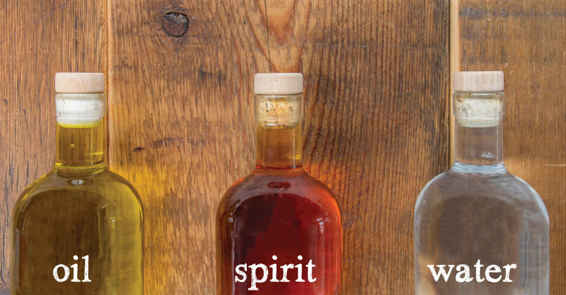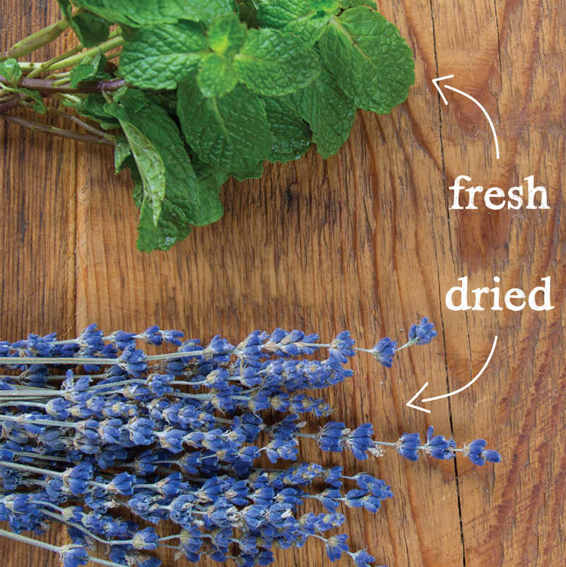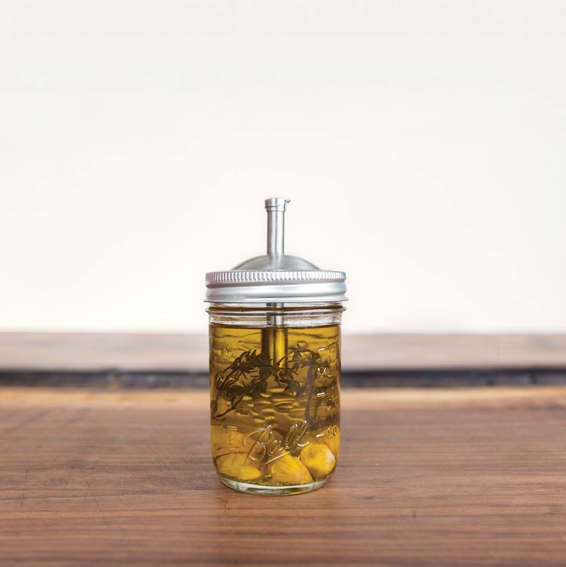Infuse: Oil, Spirit, Water (3 page)
Read Infuse: Oil, Spirit, Water Online
Authors: Eric Prum,Josh Williams

Not long ago, we found ourselves with Mason jars full of all these delicious infusions, and no way of pouring them without spilling all over ourselves (and our guests). To avoid any more costly plaid shirt replacements, we designed a stainless steel infuser top that attaches to any regular-mouth Mason jar, allowing you to infuse and dispense neatly. We call it
the Mason Tap.

Oil, spirits, and water are the three
base liquids we most love to infuse. As each of these liquids has its own unique infusing technique, we’ve divided
Infuse
into three sections.

 Given the high viscosity of oil, the infusion process for oils often requires a bit of physical effort. You’ll need to cut, muddle, and shake the flavoring ingredients with the thick oil to coax out the flavors. A little effort goes a long way, though: Oil also acts as a preservative. By protecting the ingredients from outside air, many of our oil infusions will last, sealed, for long periods of time.
Given the high viscosity of oil, the infusion process for oils often requires a bit of physical effort. You’ll need to cut, muddle, and shake the flavoring ingredients with the thick oil to coax out the flavors. A little effort goes a long way, though: Oil also acts as a preservative. By protecting the ingredients from outside air, many of our oil infusions will last, sealed, for long periods of time.
 Spirits are efficient (and delicious) base liquids for infusions. Alcohol accelerates the extraction of flavors from ingredients, resulting in short infusing times and tasty infusions. The possibilities for spirit infusions abound and include everything from homemade liqueurs to flash-infused flavored spirits. Similar to oils, the alcohol in spirits acts as a preserving agent, adding to the lifespan of your concoctions.
Spirits are efficient (and delicious) base liquids for infusions. Alcohol accelerates the extraction of flavors from ingredients, resulting in short infusing times and tasty infusions. The possibilities for spirit infusions abound and include everything from homemade liqueurs to flash-infused flavored spirits. Similar to oils, the alcohol in spirits acts as a preserving agent, adding to the lifespan of your concoctions.
 Water pairs best with fresh ingredients such as fruit, herbs, and even vegetables to create flavored waters and cold-brewed iced teas. Water infusions generally have a shorter shelf life than oil and spirit infusions, as water doesn’t act as a preservative like the other liquids. Because of this, infused waters should generally be kept refrigerated and enjoyed soon after being prepared.
Water pairs best with fresh ingredients such as fruit, herbs, and even vegetables to create flavored waters and cold-brewed iced teas. Water infusions generally have a shorter shelf life than oil and spirit infusions, as water doesn’t act as a preservative like the other liquids. Because of this, infused waters should generally be kept refrigerated and enjoyed soon after being prepared.


Two types of
ingredients are used in infusions: fresh and dried. Each produces different flavors in the infusing process. Using fresh ingredients like mint sprigs, strawberries, or cucumber slices produces bright, punchy, high notes for your infusion. On the other hand, dried ingredients such as lavender, tea leaves, and coffee can produce richer, more subtle flavor profiles in the finished product. We sometimes use both fresh and dried ingredients in our infusions to create a balance of flavors that hit on multiple levels, such as in our
cold-brewed teas
, which combine the deep flavors of dried tea leaves with the fresh notes of seasonal fruit.

Time is one of the most important factors in making infusions. When you choose to stop the infusing process determines the level and types of flavors you’ll taste in the final product. We see three basic categories of infusions, broken down by time:


